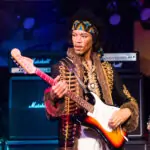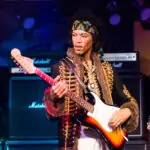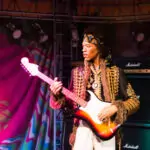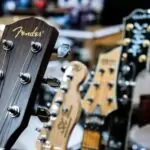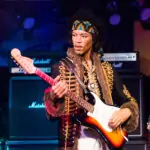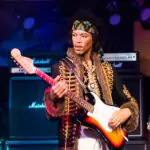Jimi Hendrix, one of the most influential and talented guitarists of all time, created a spectacle on stage that left audiences in awe. In 1967, at the Monterey Pop Festival, Hendrix made history when he set his guitar on fire during his performance. This act not only grabbed the attention of music critics and fans alike but also solidified his status as a rock legend.
This iconic performance was about more than just showmanship. The act of burning his guitar held significant meaning for Hendrix, as it showcased his dedication to his craft and his willingness to push boundaries. By setting fire to his instrument, Hendrix sought to demonstrate that he was more than just a skilled musician and that his passion for music was unmatched.
Key Takeaways on Why Did Jimi Hendrix Burn His Guitar?
- Jimi Hendrix burned his guitar as a symbol of his passion and dedication to music
- The legendary performance cemented his status as a rock icon
- This daring act had lasting effects on rock music and influenced future generations of musicians.
Also don’t miss:
- Why Jimi Hendrix is The Best Guitarist Of All Time?
- What Genre Did Jimi Hendrix Play?
- Why is Jimi Hendrix Famous?
Emergence of Jimi Hendrix in London
Jimi Hendrix, an American guitarist, arrived in London in late 1966 and quickly made a lasting impact on the music scene. With his band, the Jimi Hendrix Experience, he forged a new soundscape that stretched the blues to an outer limit of expression. Hendrix’s innovative and ethereal sound was both dangerous and sublime, winning the admiration of British musicians and fans alike.
One of the key figures in Hendrix’s rise to fame in London was Chas Chandler, a former member of The Animals, who became his manager and helped him form the Jimi Hendrix Experience. Composed of Noel Redding on bass and Mitch Mitchell on drums, the band quickly gained prominence in Europe, with their debut single, “Hey Joe,” climbing the charts.
As Hendrix’s popularity grew in London, he caught the attention of Pete Townshend, the guitarist for The Who. Impressed by his talent, Townshend invited Hendrix to join them for a British tour. This opportunity exposed Hendrix to a wider audience and solidified his reputation as an innovative and groundbreaking musician.
During his time in London, Hendrix experimented with various music genres and paved the way for a new form of rock and roll. Known for his electric performances and mastery of the guitar, Hendrix left an indelible mark on the British music scene. Journalist Keith Altham even recounts the groundbreaking moment when Hendrix burned his guitar on stage, further solidifying his legendary status.
Jimi Hendrix’s arrival and subsequent emergence in London had a profound impact on the music landscape, leaving an everlasting legacy. With the help of influential figures like Chas Chandler and Pete Townshend, the Jimi Hendrix Experience introduced a unique and groundbreaking sound that would forever change the face of rock music.
The Legendary Performance At Monterey Pop Festival
Behind The Scene Preparations
At the Monterey Pop Festival in June 1967, Jimi Hendrix delivered an unforgettable performance that would forever secure his place in rock ‘n’ roll history. As the bass and drums set the stage, Hendrix stood poised and ready with his trusty guitar.
On his hands was a 1966 Black Fender Stratocaster, the perfect instrument to aid his expressive playing style and powerful stage presence. However, it’s what happened at the climax of the performance that truly set the event apart.
Before the show, Hendrix and his team prepared for a spectacular finale to the performance. The idea was to create a dramatic and unforgettable conclusion to his set.
Hendrix decided to incorporate fire into the act, which meant ensuring he had the necessary materials, like lighter fluid, on hand to pull it off. They also had to account for the safety of both the audience and themselves during the performance.
The Act of Burning The Guitar
As Hendrix played the last notes of “Wild Thing,” the audience was electrified. Little did they know, they were about to witness a moment that would leave an indelible mark on the annals of rock. With a practiced hand, Hendrix doused his prized Fender Stratocaster in lighter fluid, struck a match, and set the instrument ablaze. Flames engulfed the Strat, reaching high into the air.
This act of burning the guitar was not only artistic expression but also a calculated move to generate buzz for Hendrix both on and off the stage. As the burning guitar reduced to ashes, the audience was spellbound by the imagery and sheer audacity of the act.
The spectacle brought both the Monterey Pop Festival to a definitive close and Jimi Hendrix’s name into the annals of rock ‘n’ roll history. The image of the flaming guitar remains as an icon of wild, unrestrained passion and artistic expression in the world of music.
Significance of the Burning Guitar Act
Public and Media Reaction
Jimi Hendrix’s decision to burn his guitar on stage caught the attention of the public and media. At the time, it was challenging for musicians to distinguish themselves, and Hendrix’s manager, Chas Chandler, believed that such a striking act would generate headlines and PR, ultimately helping Hendrix gain more recognition.
This act was first performed in March 1967 during a European tour, and the daring performance was met with astonishment and disbelief. People had never seen anything quite like it, and as a result, the image of Hendrix setting his guitar on fire became iconic.
Jimi Hendrix’s guitar-burning act at the 1967 Monterey International Pop Music Festival received widespread coverage, further solidifying his image as a rebellious and innovative musician.
Influence on Hendrix’s Career
The burning guitar stunt had significant implications for Jimi Hendrix’s career. Although he was already an accomplished musician, the act propelled him into the spotlight and allowed him to establish himself as an innovative and electrifying performer. The burning guitar served as a symbolic representation of Hendrix’s passion for music and his willingness to push boundaries.
As Hendrix’s success grew, the guitar-burning stunt continued to play a role in his career. He repeated the act twice, using at least three guitars in the process. One of the burned guitars, a 1965 Stratocaster, was eventually auctioned off for £280,000 in 2008, demonstrating the lasting impact that Hendrix’s daring performances had on the music world.
The burning of his guitars not only helped Hendrix establish his place in the music industry but also contributed to the development of his unique and unforgettable stage presence. By taking such bold risks, Jimi Hendrix managed to captivate audiences across the globe and leave an indelible mark on music history.
Aftermath and Legacy
Auction of the Burnt Guitar
In 2008, one of Jimi Hendrix’s burnt guitars was sold at auction for £198,000. The guitar was a Stratocaster, which had been in the possession of Mitch Mitchell, the drummer of the Jimi Hendrix Experience, until the early 1990s.
Impact on Future Performances
Jimi Hendrix’s infamous guitar-burning stunt at the Monterey Pop Festival in 1967 made a significant impact on his future performances. This act generated buzz around his name and showcased his unique talent to a wider audience. Furthermore, Hendrix’s guitar-burning paved the way for other artists to engage in similar acts of on-stage destruction for shock value and attention.
During his US tour and his legendary Woodstock performance, Hendrix was able to captivate audiences with his unparalleled musicianship, showmanship, and guitar-playing techniques. His actions at Monterey and beyond solidified his status as one of the most influential and innovative guitarists in music history.
Frequently Asked Questions
What was the significance of Jimi Hendrix burning his guitar?
Jimi Hendrix burned his guitar as a way to stand out and make an impact in the competitive music scene at the time. It was a bold performance art, giving Hendrix a unique edge over other musicians and attracting attention from both the general public and media.
The act of burning his guitar became a symbol of his fiery, passionate style of playing as well as his determination to make a name for himself in the industry
At which event did Jimi Hendrix burn his guitar?
Jimi Hendrix famously burned his guitar at the Monterey International Pop Festival on June 18, 1967. This iconic moment happened during his breakthrough performance in the United States.
How many times did Hendrix burn his guitar?
There isn’t an exact number of times Hendrix burned his guitar, but he first ignited it at the Astoria Theatre in London on March 31, 1967,before later burning it at the Monterey International Pop Festival.
He continued to light his guitar on fire a few more times during his career as a part of his live performances.
What happened to the burned guitar after the performance?
The burned guitars from Hendrix’s performances were often damaged beyond repair. Many of these destroyed instruments ended up in the possession of collectors or museums. The guitar that Hendrix burned at the Monterey Pop Festival in 1967 remains one of the most famous pieces of rock memorabilia.
Did any other musicians copy Hendrix’s guitar-burning act?
Jimi Hendrix’s act of burning his guitar influenced other musicians as a form of performance art. For example, Pete Townshend of The Who was known to smash his guitars on stage. However, Hendrix’s act of setting his guitars on fire remains uniquely associated with his image and stage performance.
What was the reaction of the audience and media to this incident?
The audience and media were shocked and fascinated by Jimi Hendrix’s guitar-burning act. It quickly became a sensational story, contributing to Hendrix’s legendary status and legacy as a groundbreaking performer.
The act helped to solidify his place in music history and made him one of the most iconic musicians of the 20th century.

My name is Howard Matthews and I have been playing the guitar since I was knee-high. My parents like to joke that I was pulling the strings even before I was born. In fact, one of my earliest memories is sitting on the couch with my dad’s guitar, wreaking havoc on the chords.
Now, 40 years later, I can attest that I play them much better than I did back then. I have followed in the footsteps of both my parents – much to their delight – and have been the main guitarist in my band for the best part of three decades.
Music has always been my passion, and until recently my life has been so consumed with it that I haven’t had a moment to have a breath (and I wouldn’t have it any other way)!


